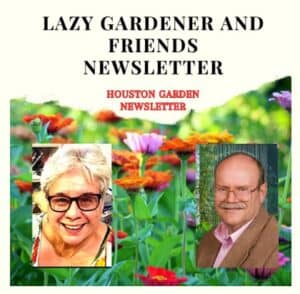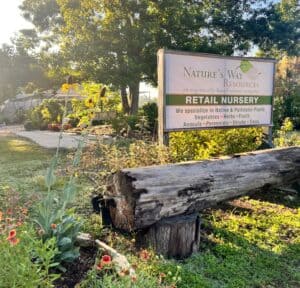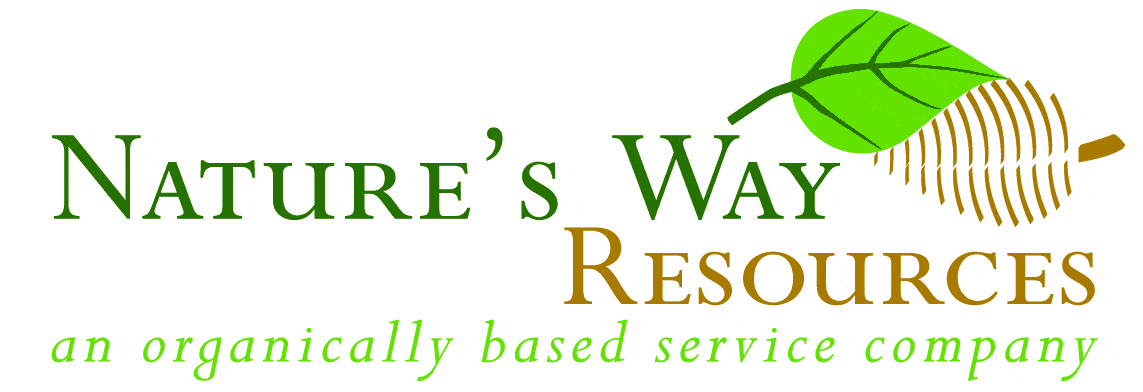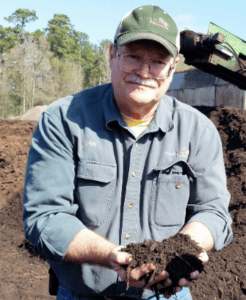 Nature’s Way Resources is proud to produce & email you this free weekly newsletter. We have no ads, but sponsors do graciously help support this project as a public service. Please note their names below & show your gratitude for this free service by patronizing their businesses! To become a sponsor, call (936) 273-1200
Nature’s Way Resources is proud to produce & email you this free weekly newsletter. We have no ads, but sponsors do graciously help support this project as a public service. Please note their names below & show your gratitude for this free service by patronizing their businesses! To become a sponsor, call (936) 273-1200
Nature’s Way Resources owner John Ferguson, “The Lazy Gardener” Brenda Beust Smith and Pablo Hernandez welcome your feedback and are so grateful to the many horticulturists who contribute their expertise
Click here to join our email list
CLICK HERE for PDFs OF PAST LG&F NEWSLETTERS
“Nature will never hesitate to starve you in the drought, drown you in the rain, burn you in the sun, and kill you with an earthquake, a hurricane . . . nature should always be seen as an enemy not a friend. It’s so dry the trees are bribing the dogs.”
— Mouloud Benzadi: Anglo Algerian author, translator and researcher
NOW — BEFORE 100º+ BECOMES REGULAR THREAT — PREPARE TO PROTECT PRECIOUS PLANTS!
BY BRENDA BEUST SMITH
Now that we have previews of heat & heavy rains to come, what we need are great horticulturists’ tips, such as Jeffery Heilers’ water-collecting ideas! First, a few gardening tips from this “Retired Mercer Arboretum & Botanic Gardens Horticultural Operations Coordinator” !

JEFFERY’S home (left) is fronted by mixed plantings that provide a rainbow of colors when blooming. The yellow curb “wall planting” is a mix of yellow four o’clocks , blue salvia, a dwarf pomegranate and yellow shrimp plants, all of which have same dark green leaf color with different accents! Rest of photos: plantings from his yard and a glen garden he shares with neighbors.
THANKS to JEFFERY for these great pictures above of his garden (and one shared with neighbors) and for the following great tips about rainwater harvesting (below): With his system, Jeff wrote, “I get about 50 gallons every three days.” How? Jeff details below:
 “If you are purchasing city water that is 500 to 600 gallons a month plus the sewer fee for the water purchase, not being a mathematician it comes to about equal to a large water bill . Plus great clean water. “The condensation is normally piped into your house drain line but I used to collect it in the Mercer (Potting shed just in five gallon bucket . This container (at left) is the one offered by the water department. I added the facet at the base found it worked best with a narrow hose; the larger hose drained to quickly so lost this precious resource as runoff.”
“If you are purchasing city water that is 500 to 600 gallons a month plus the sewer fee for the water purchase, not being a mathematician it comes to about equal to a large water bill . Plus great clean water. “The condensation is normally piped into your house drain line but I used to collect it in the Mercer (Potting shed just in five gallon bucket . This container (at left) is the one offered by the water department. I added the facet at the base found it worked best with a narrow hose; the larger hose drained to quickly so lost this precious resource as runoff.”
“The other pipe (right) is the overflow pan in case the unit freezes up with dust . I did this very low technique with a 1932 house.
Jeffery adds: “My ferns and peacock gingers seem to love this water source and when I have enough, I drench the crotons and caladiums.”
PS. JOHN FERGUSON heartily approves, adding “Basically true. AC’s with large condensers will produce more condensate than small AC’s. For years i had my condensate line directly discharge on my bananas and they loved it.”

REALLY INTO BUTTERFLIES?
 A little early but time to investigate National Butterfly Center‘s Nov. 1-4. 2025’s 29th Annual Texas Butterfly Festival.
A little early but time to investigate National Butterfly Center‘s Nov. 1-4. 2025’s 29th Annual Texas Butterfly Festival.
Not familiar with this national treasure which draws visitors from across the nation and beyond? Located in butterfly-rich Mission in South Texas, this nonprofit group is not a “butterfly house, but rather a 100-acre, nature center planted specifically planted for butterflies, and supported by admission fees, programs, plant/gift shop sales and donations.Early reservations are encouraged for off- & on-site activities (including target-species excursions) that usually draw large serious crowds. Click links above for details.
 LOOKING FOR RAINY DAY GARDENING READING FIX? Might click on “John Fairey Garden” (nee Peckerwood Garden) website. This very special garden near Hempstead has an incredible history. Altho not regularly open to public, they do have periodic Open Days and Plant Sales, some members only, some public. If it suits your gardening needs, membership will become a must! At very least, just reading about it is worth the time of even lazy gardeners!
LOOKING FOR RAINY DAY GARDENING READING FIX? Might click on “John Fairey Garden” (nee Peckerwood Garden) website. This very special garden near Hempstead has an incredible history. Altho not regularly open to public, they do have periodic Open Days and Plant Sales, some members only, some public. If it suits your gardening needs, membership will become a must! At very least, just reading about it is worth the time of even lazy gardeners!
- KATY AREA GARDENER vs. HOA FRONT YARD PLANTING RULE Can’t comment on specific problems, but seems to be growing problem with native plant lovers. If working with your HOA doesn’t help (best route), Texas Property Code Section 202.007 allows homeowners to implement xeriscaping without facing prohibitive HOA regulations. See if any of this info helps your cause.
 ATTN. GARDEN/PLANT GROUPS — Nature’s Way Resources offers free guided tours of NWR’s extensive nursery/soil/mulch facilities for garden clubs, plant societies and other plant-oriented, organized groups. As usual, NWR’s now-expanded meeting site is free to above groups. Reservations a must for both. Great time to visit!
ATTN. GARDEN/PLANT GROUPS — Nature’s Way Resources offers free guided tours of NWR’s extensive nursery/soil/mulch facilities for garden clubs, plant societies and other plant-oriented, organized groups. As usual, NWR’s now-expanded meeting site is free to above groups. Reservations a must for both. Great time to visit!
- SUBMITTING CALENDAR EVENTS?: For next upcoming newsletter, submit in exact format (see top of calendar below. Reformatting = delay)
Brenda Beust Smith’s column is based on her 40+ years as the
Houston Chronicle’s “Lazy Gardener” column, continuing sponsored by Nature’s Way Resources in 2013 — (lazygardenerbrenda@gmail.com)
Brenda’s column focuses ONLY on the Greater Houston Area
John’s Corner
NEWS FROM THE WONDERFUL WORLD
OF SOIL AND PLANTS
Subject: growing plants, human and animal health
I am in the process of designing the landscaping for my retirement home. A series of recent events is making me change the design and the plant species I will use.
I was at a restored prairie last Saturday that had been burned (prescribed fire) a few months earlier. What caught my attention was all the life from insects, butterflies, to lizards, rodents and birds. There were dozens of species of forbs and wildflowers, maybe hundreds of species of each with few grass species. An adjacent plot that was burned two years earlier had many more grass species than forbs as the natural progression had occurred.
Each of these plants collected different nutrients (elements) into their tissue from the soil. When the buffalo grazed these prairies, they received a wide range of minerals by eating different species of plants.
I often look out my office window and watch deer feed. Similarly, to buffalo, they eat many plant species with lots of forbs, vines, acorns, flowers, and a few grasses. The beneficial nutrients they consume become concentrated in their meat.
Bacteria in the gut of ruminants (sheep, deer, cows, buffalo, etc.) also produce fatty acids called CLA (conjugated linoleic acid) that are essential for good health and even fighting cancer. CLA often varies with the season, an Australian study found that CLA content of dairy was 300-400% higher in spring and summer.
This made me start thinking about what else is different about how wild animals feed versus cattle.
For example, most of us know that spinach is good for us and provides elements like magnesium for our bodies. However, if all we had to eat was spinach, we would die of malnutrition.
I had to ask myself what do we feed cattle? Most cattle are fed in feedlots with grains from corn or soy which are not their natural foods, however it makes them gain weight fast, which brings in more money at the market, but leaves harmful chemicals in the meat. The other common type cattle feed is grass and hay, what is known as “grass fed” beef. As I drive around the ranches in the area, I notice that the primary grass is coastal Bermuda, a single species like spinach.
This will lead to nutritional deficiencies for cattle, so what does a rancher do. He then provides a salt-mineral block. Livestock prefer to eat natural forages over ground up rock minerals to get the elements they require. The animals will eat enough to survive but not enough for their optimum health.
“This is similar to the FDA’s RDA (Recommended Daily Allowance) recommendation for nutrients and the levels needed for optimum health. The RDA for vitamin D is 400 IU per day, however, expose your skin to sunlight for 20 minutes and the body produces 20,000 IU and then shuts off. Who knows best – the FDA or our bodies designer? This is a gap of 50X from the supposed minimum level needed to survive and the optimal level needed to thrive.
When animals are provided with minerals in the form of ground-up rocks the animals will consume what they need to survive, but not necessarily what is needed to thrive. This results in nutrient poor meat.
Some minerals are absent or present in too small of quantities, because of variations in a parent bedrock and because of weathering. There are regions where you can have ideal grazing management and soil microbiome regeneration, and the forages will still be deficient in selenium, iodine, cobalt, molybdenum and other elements.
No matter how much you improve carbon cycling and soil health, it remains essential to address these minerals as soil amendments if you desire them to be present in your forages.” Acres USA
It is the same in growing plants in our gardens, from flowers to fruits. If proper amounts of elements are missing, we see more insect and disease issues, less heat tolerance and less resistance to heat stress, etc. This is why I always recommend 40 lbs. of remineralizer per 300-400 square feet every 5-6 years.
Cattle are subject to a disease called mastitis, cows with adequate selenium levels do not get mastitis. The stroke belt runs through Texas and up into the mid-west, it is an area where there is very little selenium in the soil. We could look at soils along the Canadian border where most are deficient in iodine, hence the human population are also deficient.
Another study in the Journal of Science of Food and Agriculture (February 2019) compared the nutritional properties of organic raised meat to conventional meat. They looked at bioactive compound’s coenzyme Q10, carnosine, anserine, creatine, and taurine. The organic beef had 17% less cholesterol, 32% less fat, 16% less fatty acids, and 24% less monounsaturated fatty acids. Of the good stuff it had 170% more alpha-linolenic acid, 24% more alpha-tocopherol, 53% more beta-carotene, 34% more coenzyme Q-10, and 72% more taurine. This another study that shows even when we raise grass organically, the way God does it in nature, it affects the health of animals and the health of people that eat the animals.
The paper above indicates how just going organic, improved the quality and nutrients in meat. Imagine what would happen if we applied rock minerals to the soil with all the elements and brought back the prairie with hundreds of species of plants for the cattle and other animals to eat. Maybe one of the reasons buffalo migrated was to eat plants grown on different soils to get the different minerals in them.
Again, we have taken something God has given us (meat) and ruined it.
SPONSORSHIP
If you are interested in becoming a sponsor, please contact us at 936-273-1200 or send an e-mail to: lazygardenerandfriends@gmail.com
ABOUT US
BRENDA BEUST SMITH
WE KNOW HER BEST AS THE LAZY GARDENER . . .
but Brenda Beust Smith is also:
- a national award-winning writer & editor
- a nationally-published writer & photographer
- a national horticultural speaker
- a former Houston Chronicle reporter
When the Chronicle discontinued Brenda’s 45-year-old Lazy Gardener” print column — started in the early ’70s as a fun side-project to reporting, it then ranked as the longestrunning, continuously-published local newspaper column in the Greater Houston area. The name, she says, is not just fun, it’s true.
Brenda’s gradual sideways step from reporter into gardening writing led first to an 18-year series of when-to-do-what Lazy Gardener Calendars, then to her Lazy Gardener’s Guide book which morphed into her Lazy Gardener’s Guide on CD, which she now emails free upon request.
Brenda became a Harris County Master Gardener and, over the years, served on theboards of many Greater Houston area horticulture organizations. She hosted local radio and TV shows, most notably a 10+-year Lazy Gardener specialty shows on HoustonPBS (Ch. 8) and her call-in “EcoGardening” show on KPFT-FM.
For over three decades, Brenda served as Assistant Production Manager of the GARDEN CLUB OF AMERICA’S “BULLETIN” magazine. Although still an active broad-based freelance writer, Brenda’s main focus now is THE LAZY GARDENER & FRIENDS HOUSTON GARDEN NEWSLETTER with John Ferguson and Pablo Hernandez of Nature’s Way Resources.
A native of New Orleans and graduate of St. Agnes Academy and the University of Houston, Brenda lives in Humble, TX, and is married to the retired Aldine High School Coach Bill Smith. They have one son, Blake.
Regarding this newsletter, Brenda is the lead writer, originator of it and the daily inspiration for it. We so appreciate the way she has made gardening such a fun way to celebrate life together for such a long time.
About her column, Brenda says: “I don’t consider myself a ‘garden writer.” I started out 50+ years ago as a very lazy “gardening reporter.” I still feel that way today. I hope my columns inspire/help newcomers, but I do not write to them. I write to very experienced gardeners who want to expand their horizons.
JOHN FERGUSON
John is a native Houstonian and has over 35 years of business experience. He owns Nature’s Way Resources, a composting company that specializes in high quality compost, mulch, and soil mixes. He holds a MS degree in Physics and Geology and is a licensed Soil Scientist in Texas.
John has won many awards in horticulture and environmental issues. For years he represented the composting industry on the Houston-Galveston Area Council for solid waste. His personal garden has been featured in several horticultural books and “Better Homes and Gardens” magazine. His business has been recognized in the Wall Street Journal for the quality and value of their products. He is a member of the Physics Honor Society and many other professional societies. John is the co-author of the book Organic Management for the Professional.
For this newsletter, John contributes articles regularly and is responsible for publishing it.
PABLO HERNANDEZ Pablo Hernandez is the special projects coordinator for Nature’s Way Resources. His realm of responsibilities include: serving as a webmaster, IT support, technical problem solving/troubleshooting, metrics management and quality control. Pablo helps this newsletter happen from a technical support standpoint.
Download the Newsletter with Our Events Calendar Below!


